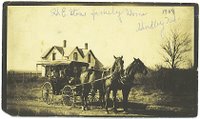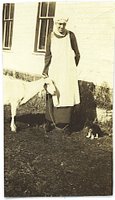
Nellie Mary Story had moved to Peterson, Iowa from Virginia in the spring of 1879 with her parents, twin sister, three brothers and one other sister. It was there that she met George Washington Paul and they were married on December 26, 1883.
George and Nellie lived a rather nomadic life, moving from place to place as George found run down farms to purchase cheaply. The family would make improvements and then resell and move on. By the time May was born in June, 1884,and Wilbur was born in 1887, they had moved to Basehor, KS. In December of 1888, William was born in Leroy, MO, but they were back at Bashor in June, 1891 when Olive was born. In February, 1894, George was born in Hennesy, TX, and they moved on to Madisonville, TX where Lillie was born in 1897 and Florence was born in 1899. The next move was to Milo, near Nevada, MO where Julia was born in July of 1903, and to Cherry County, NE in 1907 when Earl was born. We know of many other moves because Julia told of living in eastern Colorado, western Nebraska, and Texas. These moves were made in a covered wagon except for the one from eastern Colorado to Alvo, NE.
There was not room in the wagon for anything but essentials so any toys or personal possessions belonging to the children were left behind. The children had to labor at whatever work was at hand, building up a farm or working out for cash. Julia told of having to pick cotton in Texas and pulling the long bags behind her down the row. She would have been about nine years old.
With each move Nellie and the children did most of the work of rebuilding the house and picking up the rocks from the fields. Usually, a few months during the last year of living in each place, George was off searching for another place to locate. Nellie and the children repeated the cleaning up and building up only to have the place sold and the story was repeated again.
Ollie remembered in 1903, when she was 12 years old, her little sister Julia was born. The children were sent upstairs to bed, at an unusual hour, and were naturally quite curious about just what was going on downstairs, until they heard a baby cry.
Across the field from where they had picked up rocks, ran a stream in which the kids sometimes played. One day one of the boys threw the family cat in the water, and then made Ollie carry it to the house. George was well known for his temper and never took time for questions before meting out his form of justice, and Ollie took a whipping for that wet cat.
Another time Ollie remembered that once when her father was away on one of his many treks to locate a new place to move on to and had left strict instructions with her mother to hire a certain neighbor to cut the oats. When the time came, Nellie had dutifully made the date for July 4th. There was a celebration in Milo and the boys begged to go, arguing that their father need never know. So Nellie sent them to the neighbor again to see if he would be willing to wait until July 5th. He agreed, probably glad for the kids' sake. So they all went to Milo and ate a picnic lunch in the school yard.
The family didn't remain long enough to finish the house at Milo,MO. but Ollie remembered vivid accounts of picking up rocks in the fields to make them tillable. These rocks were used to build a stone wall on the north side of the yard. To a 12 year old the height of this wall was tremendous. In 1957, Ollie was taken back to the location of the farm, by two of her children. She found an old schoolmate who remembered her and who now owned the old farm. The farm was a lovely spot, the house stood on a pretty grassy slope. Ollie remembered getting that grassy yard in shape and setting out trees there. She was disturbed at the low height of the stone wall and knew after all the back breaking work it had to be taller than that. She found a stick and began digging out the fifty four years of dirt, leaves and debris that had collected in front of the wall and found that it really was as tall as she remembered it to be.







